
The Hygrophoraceae are a family of fungi in the order Agaricales. Originally conceived as containing white-spored, thick-gilled agarics, including Hygrophorus and Hygrocybe species, DNA evidence has extended the limits of the family, so it now contains not only agarics, but also basidiolichens and corticioid fungi. Species are thus diverse and are variously ectomycorrhizal, lichenized, associated with mosses, or saprotrophic. The family contains 25 genera and over 600 species. None is of any great economic importance, though fruit bodies of some Hygrocybe and Hygrophorus species are considered edible and may be collected for sale in local markets.

The Tricholomataceae are a large family of mushrooms within the Agaricales. Originally a classic "wastebasket taxon", the family included any white-, yellow-, or pink-spored genera in the Agaricales not already classified as belonging to e.g. the Amanitaceae, Lepiotaceae, Hygrophoraceae, Pluteaceae, or Entolomataceae.

Cyphellostereum is a genus of basidiolichens. Species produce white, somewhat cup-shaped fruit bodies on a thin film of green on soil which is the thallus. All Cyphellostereum species have nonamyloid spores and tissues, lack clamp connections, and also lack hymenial cystidia.
Acantholichen is a fungal genus in the family Hygrophoraceae. The genus was circumscribed by Norwegian lichenologist Per Magnus Jørgensen to contain the type, and at that time, only species, the basidiolichen Acantholichen pannarioides, discovered originally in Costa Rica in 1998. This species has a bluish, gelatinous thallus, and a fine, white powdery bloom covering the hairy upper surface; this surface is said to resemble "an unshaven chin". Five additional species, all basidiolichens, were added to the genus in 2016 following an in-depth analysis of specimens collected from the Galápagos, Costa Rica, Brazil and Colombia.
Aeruginospora is a genus of fungi in the family Hygrophoraceae. It was formerly placed in the family Tricholomataceae, but it was moved to the Hygrophoraceae in a recent review of the family based on its morphological similarity to Chrysomphalina and especially Haasiella. It might be that Haasiella, which differs in spore color and ecology, is a junior synonym of Aeruginospora, but this has not yet been tested in a molecular phylogenetics study. The genus, described by Franz Xaver Rudolf von Höhnel in 1908, currently contains two species found in New Zealand and Indonesia. Six species formerly placed in Aeruginospora were transferred to the genus Camarophyllopsis. A. furfuracea might also belong in Camarophyllopsis, but it has not yet been restudied.

Cantharellula is a genus of mushroom-forming fungi in the family Hygrophoraceae. The genus was described by mycologist Rolf Singer in 1936.
Haasiella is a fungal genus in the family Hygrophoraceae. It is a monotypic genus that contains only the species Haasiella splendidissima. Haasiella venustissima, formerly considered to be a distinct species based on its one and two-spored basidia, was found by a DNA study to be synonymous with H. splendidissima. H. splendidissima is only known from Europe and is saprotrophic on wood. Haasiella was described as a new genus in 1966 by Czech mycologists František Kotlaba and Zdeněk Pouzar. It is most closely related to the genus Hygrophorus.
Hygroaster is a genus of mushroom-forming fungi in the family Hygrophoraceae. The genus was described by mycologist Rolf Singer in 1955.

Pseudoarmillariella is a genus of fungi in the family Hygrophoraceae. The genus contains three species found in Central America, North America, and Asia. Pseudoarmillariella was described by mycologist Rolf Singer in 1956.
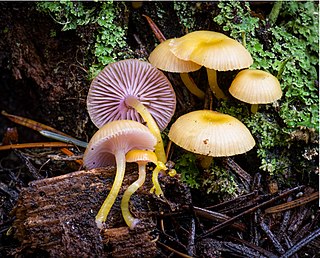
Chromosera is a genus of fungi in the family Hygrophoraceae. Within the family Hygrophoraceae it is closely related to the genus Gloioxanthomyces. It contains five species. The generic name honors the mycologist Meinhard Moser, and also alludes (chromos) to the distinct coloration of the mushrooms, by overlapping 'chromos' with 'Moser', hence Chromosera.
Semiomphalina is a basidiolichen genus in the family Hygrophoraceae. The genus is monotypic, containing the single species Semiomphalina leptoglossoides, found in Papua New Guinea.
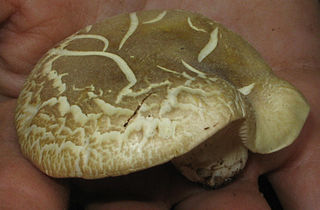
Cantharocybe is a genus of mushroom-forming fungi in the family Hygrophoraceae. The genus was described by American mycologists Howard E. Bigelow and Alexander H. Smith in 1973. Cantharocybe contains three species: the type C. gruberi, and C. brunneovelutina from Belize, reported as new to science in 2011, and C. virosa, transferred from "Megacollybia", and found in Bangladesh and India.
Aeruginospora furfuracea is a species of fungus in the family Hygrophoraceae. The species, described by Egon Horak in 1973, is found in New Zealand. It is currently placed in the genus Aeruginospora, but may actually belong in Camarophyllopsis.

Gliophorus is a genus of agaric fungi in the family Hygrophoraceae. Gliophorus species belong to a group known as waxcaps in English, sometimes also waxy caps in North America or waxgills in New Zealand. In Europe, Gliophorus species are typical of waxcap grasslands, a declining habitat due to changing agricultural practices. As a result, two species, Gliophorus europerplexus and Gliophorus reginae, are of global conservation concern and are listed as "vulnerable" on the IUCN Red List of Threatened Species.

Aphroditeola is an agaric fungal monotypic genus that produces pink cantharelloid fruit bodies on coniferous forest floors. The lamellae are forked and typically the fruit bodies have a fragrant odor described as candy-like, cinnamon-like or pink bubble gum-like.
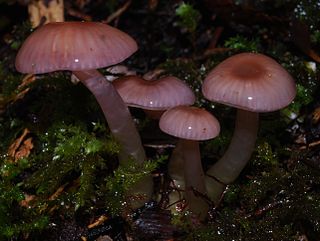
Gliophorus versicolor is a species of agaric fungus in the family Hygrophoraceae. Found in New Zealand, it was described as new to science in 1973 by mycologist Egon Horak. Within the genus Gliophorus, it is classified in the section Glutinosae, a grouping of species characterized by having bright colors, decurrent gills, and a gelatinized subhymenium. Fruit bodies have hemispherical to convex caps typically measuring 20 mm (0.8 in), although some have been recorded up to 50 mm (2.0 in). Moist caps are gluey with a color ranging from reddish brown to pinkish-lilac; the cap margin has radial grooves mirroring the gills underneath. The gills have an adnate to somewhat decurrent attachment to the stipe. They are widely spaced with color similar to the cap, or whitish. The cylindrical, hollow stipe measures 2–7 cm (0.8–2.8 in) by 1.5–3 mm (0.06–0.12 in) thick. The fungus is saprobic, and fruits on the ground among Dacrycarpus and Nothofagus.
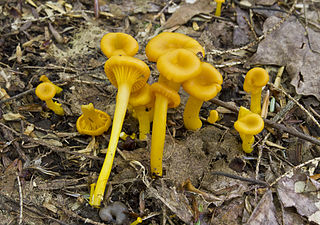
Gloioxanthomyces is a genus of fungi in the family Hygrophoraceae. It was circumscribed in 2013 to contain G. nitidus, and the type species, G. vitellinus. Within the Hygrophoracae, it is in the tribe Chromosereae and closely related to the genus Chromosera. The generic name derives from the Greek gloio ("glutinous"), xantho ("yellow"), and myces (fungus).
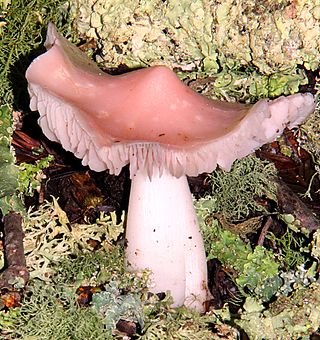
Porpolomopsis is a genus of fungi in the family Hygrophoraceae. It was circumscribed in 2008 by Andreas Bresinsky to contain P. calyptriformis. Bresinsky separated it from the genus Hygrocybe based on its color and the absence of DOPA pigments. P. lewelliniae was transferred to the genus based on DNA and morphology. Three undescribed species also belong in the genus. Species of Porpolomopsis have also formerly been placed in the genus Humidicutis, to which they are closely related but differ in having narrowly attached or free gills and the shape of the hyphae in their cap. Species of Porpolomopsis are found in Europe, North America, Asia, Australia and New Zealand.
Acantholichen pannarioides is a species of basidiolichen in the family Hygrophoraceae, and the type species of genus Acantholichen. The lichen has a bluish-tinged, gelatinous thallus with a surface texture that has a powdery to hairy texture. It is found in montane regions of Central America and northern South America, where it grows on forest litter, bark, on bryophytes, and on other lichens.
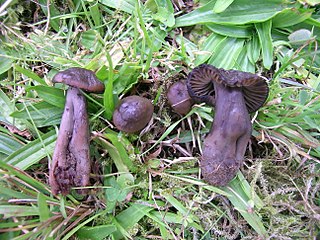
Neohygrocybe is a genus of agaric fungi in the family Hygrophoraceae. Neohygrocybe species belong to a group known as waxcaps in English, sometimes also waxy caps in North America or waxgills in New Zealand. In Europe, Neohygrocybe species are typical of waxcap grasslands, a declining habitat due to changing agricultural practices. As a result, three species, Neohygrocybe ingrata, Neohygrocybe nitrata, and Neohygrocybe ovina, are of global conservation concern and are listed as "vulnerable" on the IUCN Red List of Threatened Species.













